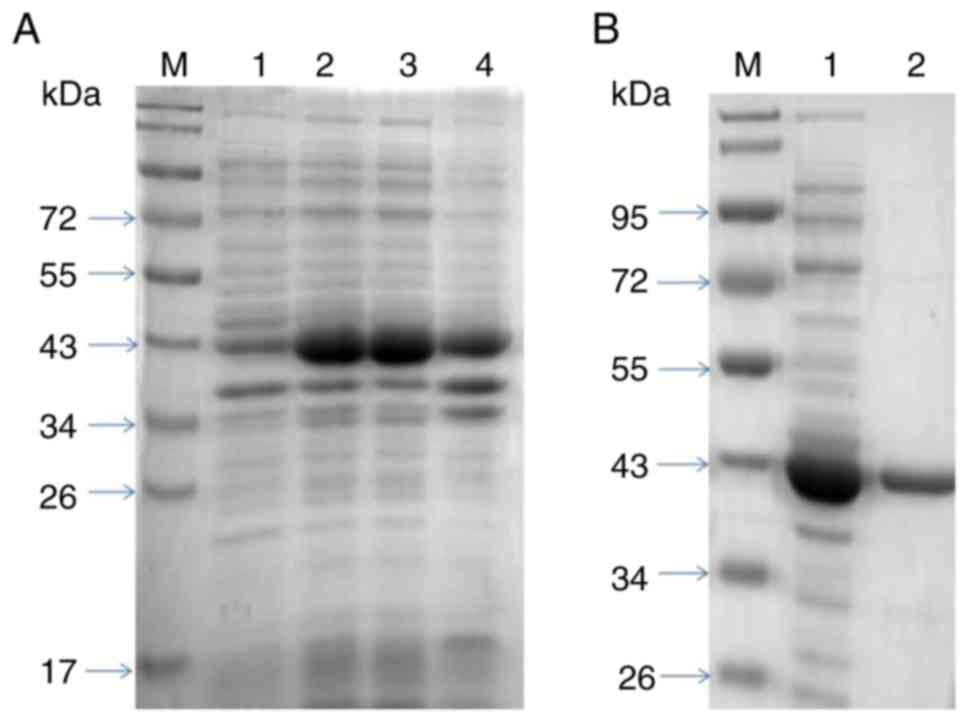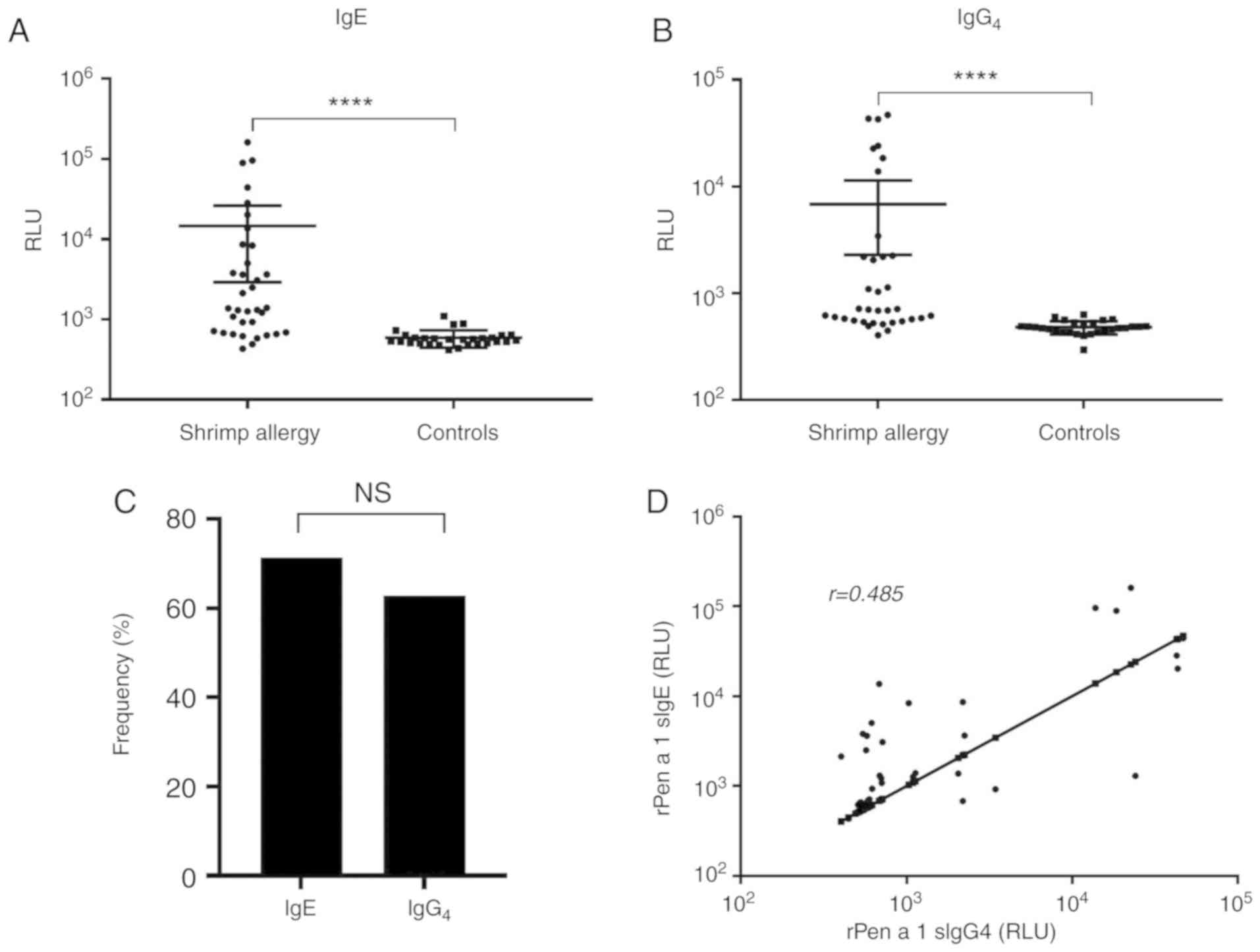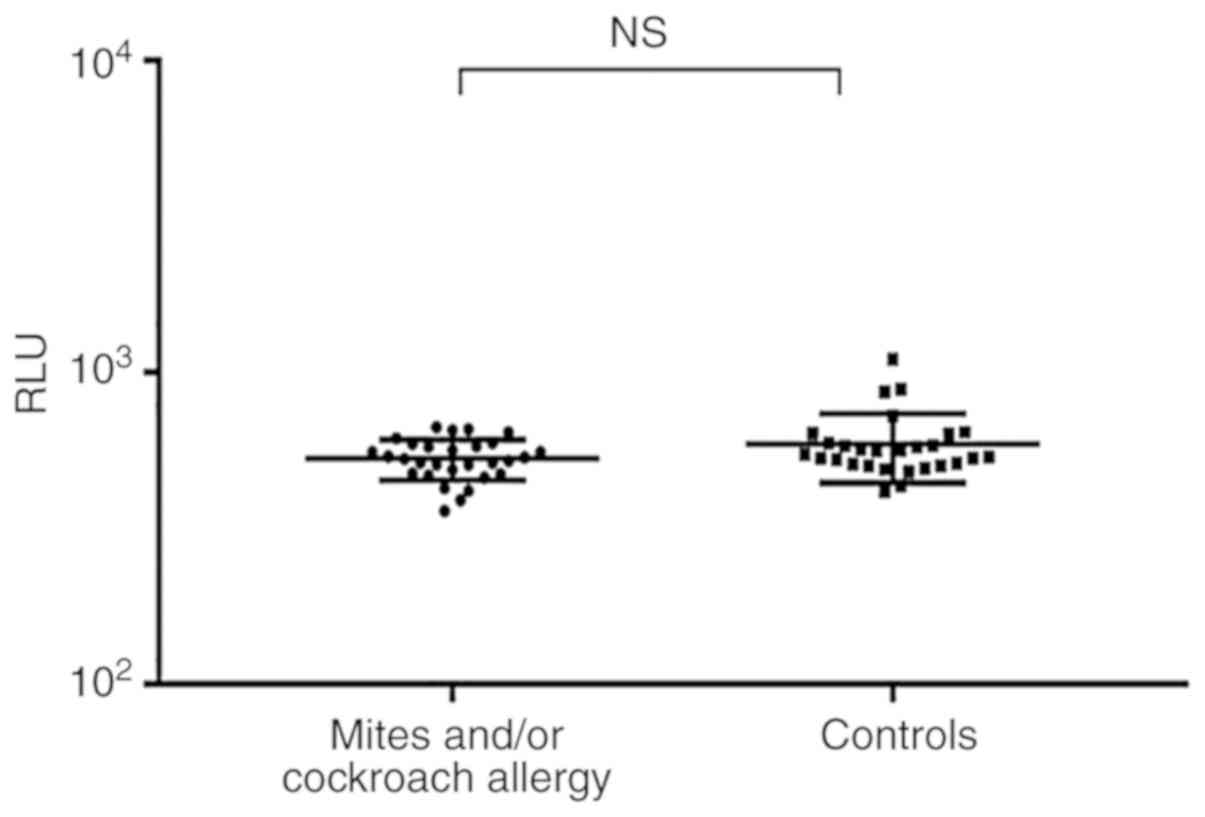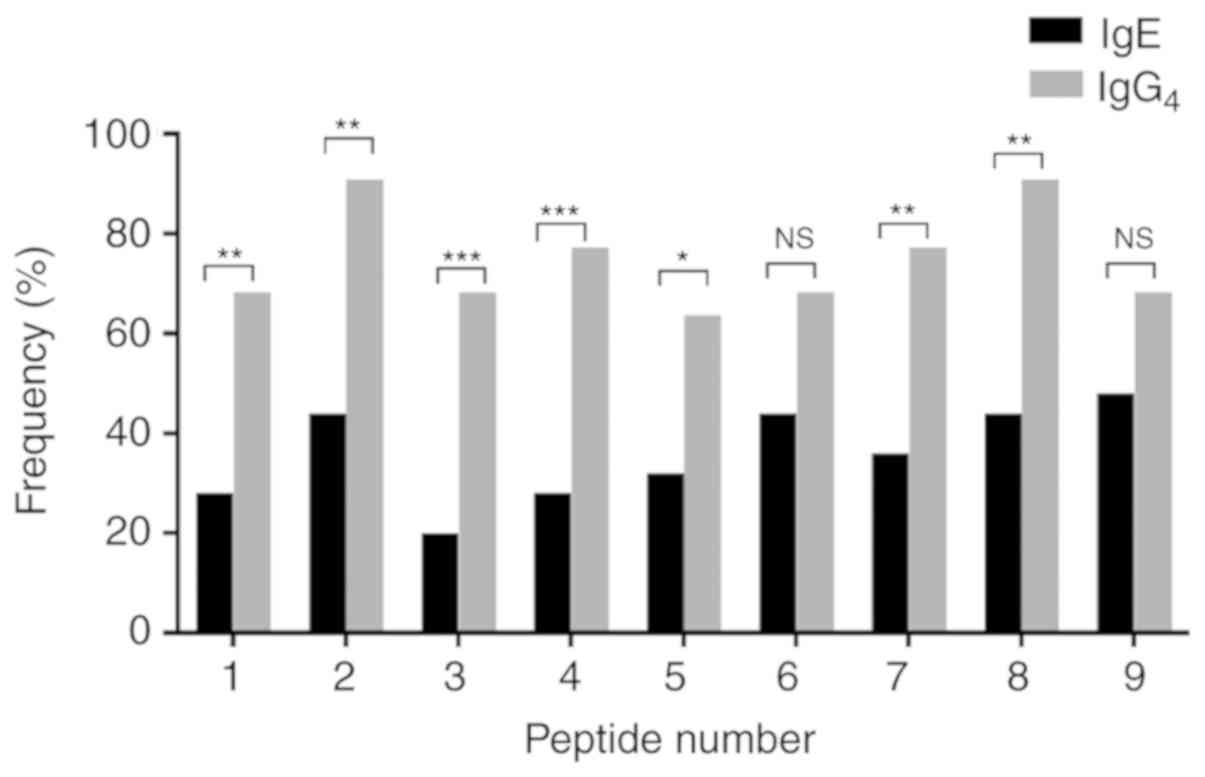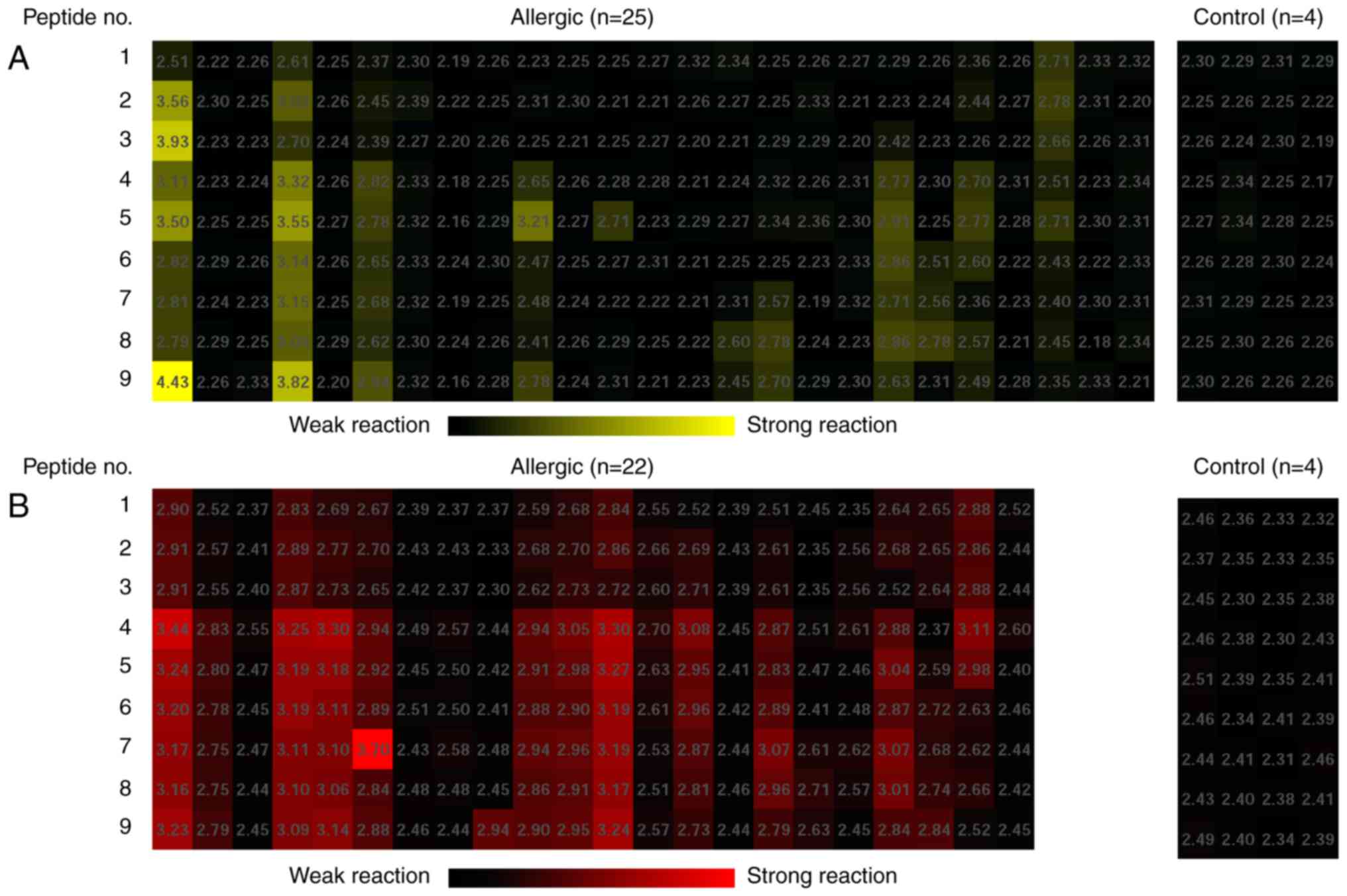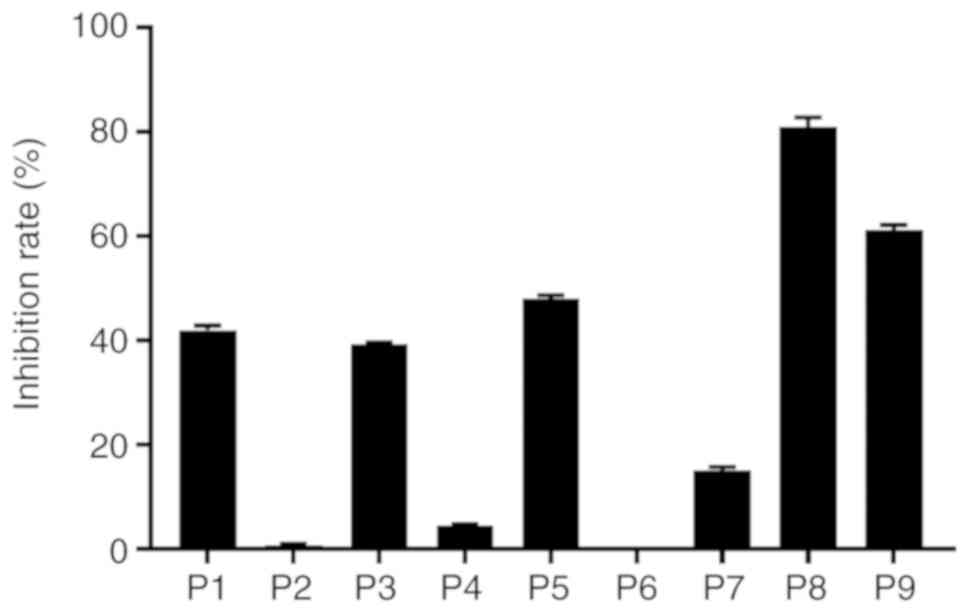|
1
|
Pedrosa M, Boyano-Martinez T, Garcia-Ara C
and Quirce S: Shellfish allergy: A comprehensive review. Clin Rev
Allergy Immunol. 49:203–216. 2015. View Article : Google Scholar : PubMed/NCBI
|
|
2
|
Khora SS: Seafood-associated shellfish
allergy: A comprehensive review. Immunol Invest. 45:504–530. 2016.
View Article : Google Scholar : PubMed/NCBI
|
|
3
|
Ruethers T, Taki AC, Johnston EB, Nugraha
R, Le TTK, Kalic T, McLean TR, Kamath SD and Lopata AL: Seafood
allergy: A comprehensive review of fish and shellfish allergens.
Mol Immunol. 100:28–57. 2018. View Article : Google Scholar : PubMed/NCBI
|
|
4
|
Naqpal S, Rajappa L, Metcalfe DD and Rao
PV: Isolation and characterization of heat-stable allergens from
shrimp (Penaeus indicus). J Allergy Clin Immunol. 83:26–36. 1989.
View Article : Google Scholar : PubMed/NCBI
|
|
5
|
Daul C, Slattery M, Reese G and Lehrer SB:
Identification of the major brown shrimp (Penaeus aztecus) allergen
as the muscle protein tropomyosin. Int Arch Allergy Immunol.
105:49–55. 1994. View Article : Google Scholar : PubMed/NCBI
|
|
6
|
Reese G, Schicktanz S, Lauer I, Randow S,
Lüttkopf D, Vogel L, Lehrer SB and Vieths S: Structural,
immunological and functional properties of natural recombinant Pen
a 1, the major allergen of Brown Shrimp, Penaeus aztecus. Clin Exp
Allergy. 36:517–524. 2006. View Article : Google Scholar : PubMed/NCBI
|
|
7
|
Albrecht M, Alessandri S, Conti A, Reuter
A, Lauer I, Vieths S and Reese G: High level expression,
purification and physico- and immunochemical characterisation of
recombinant Pen a 1: A major allergen of shrimp. Mol Nutr Food Res.
52 (Suppl 2):S186–S195. 2008.PubMed/NCBI
|
|
8
|
Faber MA, Pascal M, El Kharbouchi O,
Sabato V, Hagendorens MM, Decuyper II, Bridts CH and Ebo DG:
Shellfish allergens: Tropomyosin and beyond. Allergy. 72:842–848.
2017. View Article : Google Scholar : PubMed/NCBI
|
|
9
|
Leung PS, Chow WK, Duffey S, Kwan HS,
Gershwin ME and Chu KH: IgE reactivity against a cross-reactive
allergen in crustacea and mollusca: Evidence for tropomyosin as the
common allergen. J Allergy Clin Immunol. 98:954–961. 1996.
View Article : Google Scholar : PubMed/NCBI
|
|
10
|
Ayuso R, Reese G, Leong-Kee S, Plante M
and Lehrer SB: Molecular basis of arthropod cross-reactivity:
IgE-binding cross-reactive epitopes of shrimp, house dust mite and
cockroach tropomyosins. Int Arch Allergy Immunol. 129:38–48. 2002.
View Article : Google Scholar : PubMed/NCBI
|
|
11
|
DeWitt AM, Mattsson L, Lauer I, Reese G
and Lidholm J: Recombinant tropomyosin from Penaeus aztecus (rPen a
1) for measurement of specific immunoglobulin E antibodies relevant
in food allergy to crustaceans and other invertebrates. Mol Nutr
Food Res. 48:370–379. 2004. View Article : Google Scholar : PubMed/NCBI
|
|
12
|
Yang AC, Arruda LK, Santos AB, Barbosa MC,
Chapman MD, Galvão CE, Kalil J and Morato-Castro FF: Measurement of
IgE antibodies to shrimp tropomyosin is superior to skin prick
testing with commercial extract and measurement of IgE to shrimp
for predicting clinically relevant allergic reactions after shrimp
ingestion. J Allergy Clin Immunol. 125:872–878. 2010. View Article : Google Scholar : PubMed/NCBI
|
|
13
|
Gámez C, Sánchez-García S, Ibáñez MD,
López R, Aguado E, López E, Sastre B, Sastre J and del Pozo V:
Tropomyosin IgE-positive results are a good predictor of shrimp
allergy. Allergy. 66:1375–1383. 2011. View Article : Google Scholar : PubMed/NCBI
|
|
14
|
Matricardi PM, Dramburg S, Potapova E,
Skevaki C and Renz H: Molecular diagnosis for allergen
immunotherapy. J Allergy Clin Immunol. 143:831–843. 2019.
View Article : Google Scholar : PubMed/NCBI
|
|
15
|
Matsuo H, Yokooji T and Taogoshi T: Common
food allergens and their IgE-binding epitopes. Allergol Int.
64:332–343. 2015. View Article : Google Scholar : PubMed/NCBI
|
|
16
|
Wai CY, Leung NY, Ho MH, Gershwin LJ, Shu
SA, Leung PS and Chu KH: Immunization with Hypoallergens of shrimp
allergen tropomyosin inhibits shrimp tropomyosin specific IgE
reactivity. PLoS One. 9:e1116492014. View Article : Google Scholar : PubMed/NCBI
|
|
17
|
Asero R, Mistrello G, Amato S, Ariano R,
Colombo G, Conte ME, Crivellaro M, De Carli M, Della Torre F,
Emiliani F, et al: Shrimp allergy in Italian adults: A multicenter
study showing a high prevalence of sensitivity to novel high
molecular weight allergens. Int Arch Allergy Immunol. 157:3–10.
2012. View Article : Google Scholar : PubMed/NCBI
|
|
18
|
Roberts G, Ollert M, Aalberse R, Austin M,
Custovic A, DunnGalvin A, Eigenmann PA, Fassio F, Grattan C,
Hellings P, et al: A new framework for the interpretation of IgE
sensitization tests. Allergy. 71:1540–1551. 2016. View Article : Google Scholar : PubMed/NCBI
|
|
19
|
Siroux V, Lupinek C, Resch Y, Curin M,
Just J, Keil T, Kiss R, Lødrup Carlsen K, Melén E, Nadif R, et al:
Specific IgE and IgG measured by the MeDALL allergen-chip depend on
allergen and route of exposure: The EGEA study. J Allergy Clin
Immunol. 139:643–654.e6. 2017. View Article : Google Scholar : PubMed/NCBI
|
|
20
|
Hansen KS, Ballmer-Weber BK, Sastre J,
Lidholm J, Andersson K, Oberhofer H, Lluch-Bernal M, Ostling J,
Mattsson L, Schocker F, et al: Component-resolved in vitro
diagnosis of hazelnut allergy in Europe. J Allergy Clin Immunol.
123:1134–1141.e1-e3. 2009. View Article : Google Scholar : PubMed/NCBI
|
|
21
|
Ayuso R, Lehrer S and Reese G:
Identification of continuous, allergenic regions of the major
shrimp allergen Pen a 1 (tropomyosin). Int Arch Allergy Immunol.
127:27–37. 2002. View Article : Google Scholar : PubMed/NCBI
|
|
22
|
Reese G, Ayuso R, Carle T and Lehrer SB:
IgE binding epitopes of shrimp tropomyosin, the major allergen Pen
a 1. Int Arch Allergy Immunol. 118:300–301. 1999. View Article : Google Scholar : PubMed/NCBI
|
|
23
|
Mine Y and Wei Zhang J: Identification and
fine mapping of IgG and IgE epitopes in ovomucoid. Biochem Biophys
Res Commun. 292:1070–1074. 2002. View Article : Google Scholar : PubMed/NCBI
|
|
24
|
Jarvinen KM, Beyer K, Vila L, Bardina L,
Mishoe M and Sampson HA: Specificity of IgE antibodies to
sequential epitopes of hen's egg ovomucoid as a marker for
persistence of egg allergy. Allergy. 62:758–765. 2007. View Article : Google Scholar : PubMed/NCBI
|
|
25
|
Martinez-Botas J, Cerecedo I, Zamora J,
Vlaicu C, Dieguez MC, Gómez-Coronado D, de Dios V, Terrados S and
de la Hoz B: Mapping of the IgE and IgG4 sequential epitopes of
ovomucoid with a peptide microarray immunoassay. Int Arch Allergy
Immunol. 161:11–20. 2013. View Article : Google Scholar : PubMed/NCBI
|
|
26
|
Cerecedo I, Zamora J, Shreffler WG, Lin J,
Bardina L, Dieguez MC, Wang J, Muriel A, de la Hoz B and Sampson
HA: Mapping of the IgE and IgG4 sequential epitopes of milk
allergens with a peptide microarray-based immunoassay. J Allergy
Clin Immunol. 122:589–594. 2008. View Article : Google Scholar : PubMed/NCBI
|
|
27
|
Steckelbroeck S, Ballmer-Weber BK and
Vieths S: Potential, pitfalls, and prospects of food allergy
diagnostics with recombinant allergens or synthetic sequential
epitopes. J Allergy Clin Immunol. 121:1323–1330. 2008. View Article : Google Scholar : PubMed/NCBI
|
|
28
|
Suarez-Farinas M, Suprun M, Chang HL,
Gimenez G, Grishina G, Getts R, Nadeau K, Wood RA and Sampson HA:
Predicting development of sustained unresponsiveness to milk oral
immunotherapy using epitope-specific antibody binding profiles. J
Allergy Clin Immunol. 143:1038–1046. 2019. View Article : Google Scholar : PubMed/NCBI
|
|
29
|
Jenmalm MC and Bjorksten B: Development of
immunoglobulin G subclass antibodies to ovalbumin, birch and cat
during the first eight years of life in atopic and non-atopic
children. Pediatr Allergy Immunol. 10:112–121. 1999. View Article : Google Scholar : PubMed/NCBI
|
|
30
|
Yang Z, Zhao J, Wei N, Feng M, Xian M, Shi
X, Zheng Z, Su Q, Wong GWK and Li J: Cockroach is a major
cross-reactive allergen source in shrimp-sensitized rural children
in southern China. Allergy. 73:585–592. 2018. View Article : Google Scholar : PubMed/NCBI
|
|
31
|
Muraro A, Werfel T, Hoffmann-Sommergruber
K, Roberts G, Beyer K, Bindslev-Jensen C, Cardona V, Dubois A,
duToit G, Eigenmann P, et al: EAACI food allergy and anaphylaxis
guidelines: Diagnosis and management of food allergy. Allergy.
69:1008–1025. 2014. View Article : Google Scholar : PubMed/NCBI
|
|
32
|
Matricardi PM, Kleine-Tebbe J, Hoffmann
HJ, Valenta R, Hilger C, Hofmaier S, Aalberse RC, Agache I, Asero
R, Ballmer-Weber B, et al: EAACI molecular allergology user's
guide. Pediatr Allergy Immunol. 27 (Suppl 23):S1–S250. 2016.
View Article : Google Scholar
|
|
33
|
Dodig S and Cepelak I: The potential of
component-resolved diagnosis in laboratory diagnostics of allergy.
Biochem Med (Zagreb). 28:0205012018. View Article : Google Scholar : PubMed/NCBI
|
|
34
|
Bian Y, Liu C, She T, Wang M, Yan J, Wei D
and Li H: Development of a light-initiated chemiluminescent assay
for the quantitation of sIgE against egg white allergens based on
component-resolved diagnosis. Anal Bioanal Chem. 410:1501–1510.
2018. View Article : Google Scholar : PubMed/NCBI
|
|
35
|
Li J, Li S, Huang L, Cui Y, She T, Bian Y
and Li H: A light-initiated chemiluminescent assay for rapid
quantitation of allergen-specific IgG4 in clinical samples. Clin
Chim Acta. 489:83–88. 2019. View Article : Google Scholar : PubMed/NCBI
|
|
36
|
Ullman E, Kirakossian H, Switchenko AC,
Ishkanian J, Ericson M, Wartchow CA, Pirio M, Pease J, Irvin BR,
Singh S, et al: Luminescent oxygen channeling assay (LOCI):
Sensitive, broadly applicable homogeneous immunoassay method. Clin
Chem. 42:1518–1526. 1996. View Article : Google Scholar : PubMed/NCBI
|
|
37
|
Ullman E, Kirakossian H, Singh S, Wu ZP,
Irvin BR, Pease JS, Switchenko AC, Irvine JD, Dafforn A, Skold CN,
et al: Luminescent oxygen channeling immunoassay: Measurement of
particle binding kinetics by chemiluminescence. Proc Natl Acad Sci
USA. 91:5426–5430. 1994. View Article : Google Scholar : PubMed/NCBI
|
|
38
|
Sverremark-Ekstrom E, Hultgren EH, Borres
MP and Nilsson C: Peanut sensitization during the first 5 yr of
life is associated with elevated levels of peanut-specific IgG.
Pediatr Allergy Immunol. 23:224–229. 2012. View Article : Google Scholar : PubMed/NCBI
|
|
39
|
Huang X, Tsilochristou O, Perna S,
Hofmaier S, Cappella A, Bauer CP, Hoffman U, Forster J, Zepp F,
Schuster A, et al: Evolution of the IgE and IgG repertoire to a
comprehensive array of allergen molecules in the first decade of
life. Allergy. 73:421–430. 2018. View Article : Google Scholar : PubMed/NCBI
|
|
40
|
Hofmaier S, Comberiati P and Matricardi
PM: Immunoglobulin G in IgE-mediated allergy and allergen-specific
immunotherapy. Eur Ann Allergy Clin Immunol. 46:6–11.
2014.PubMed/NCBI
|
|
41
|
Akdis M and Akdis CA: Mechanisms of
allergen-specific immunotherapy: Multiple suppressor factors at
work in immune tolerance to allergens. J Allergy Clin Immunol.
133:621–631. 2014. View Article : Google Scholar : PubMed/NCBI
|
|
42
|
Stapel SO, Asero R, Ballmer-Weber BK, Knol
EF, Strobel S, Vieths S and Kleine-Tebbe J; EAACI Task Force, :
Testing for IgG4 against foods is not recommended as a diagnostic
tool: EAACI Task Force Report. Allergy. 63:793–796. 2008.
View Article : Google Scholar : PubMed/NCBI
|
|
43
|
Caubet JC, Lin J, Ahrens B, Gimenez G,
Bardina L, Niggemann B, Sampson HA and Beyer K: Natural tolerance
development in cow's milk allergic children: IgE and IgG4 epitope
binding. Allergy. 72:1677–1685. 2017. View Article : Google Scholar : PubMed/NCBI
|
|
44
|
Farioli L, Losappio LM, Giuffrida MG,
Pravettoni V, Micarelli G, Nichelatti M, Scibilia J, Mirone C,
Cavallarin L, Lamberti C, et al: Mite-induced asthma and IgE levels
to shrimp, mite, tropomyosin, arginine kinase, and Der p 10 Are the
most relevant risk factors for challenge-proven shrimp allergy. Int
Arch Allergy Immunol. 174:133–143. 2017. View Article : Google Scholar : PubMed/NCBI
|
|
45
|
Varshney S, Goldblum RM, Kearney C,
Watanabe M and Midoro-Horiuti T: Major mountain cedar allergen, Jun
a 1, contains conformational as well as linear IgE epitopes. Mol
Immunol. 44:2781–2785. 2007. View Article : Google Scholar : PubMed/NCBI
|
|
46
|
Lombardero M, Heymann PW, Platts-Mills TA,
Fox JW and Chapman MD: Conformational stability of B cell epitopes
on group I and group II Dermatophagoides spp. allergens. Effect of
thermal and chemical denaturation on the binding of murine IgG and
human IgE antibodies. J Immunol. 144:1353–1360. 1990.PubMed/NCBI
|
|
47
|
Hu H, Luo W, Wu Z, Cai C, Huang H and Sun
B: A pilot study on the allergen-specific IgE to molecular
components on polysensitized mite allergic asthmatic patients in
Guangzhou, China. Mol Immunol. 105:38–45. 2018. View Article : Google Scholar : PubMed/NCBI
|
|
48
|
Pascal M, Grishina G, Yang AC,
Sánchez-García S, Lin J, Towle D, Ibañez MD, Sastre J, Sampson HA
and Ayuso R: Molecular diagnosis of shrimp allergy: Efficiency of
several allergens to predict clinical reactivity. J Allergy Clin
Immunol Pract. 3:521–529. e10. 2015. View Article : Google Scholar : PubMed/NCBI
|
|
49
|
Koplin JJ, Perrett KP and Sampson HA:
Diagnosing peanut allergy with fewer oral food challenges. J
Allergy Clin Immunol Pract. 7:375–380. 2018. View Article : Google Scholar : PubMed/NCBI
|
|
50
|
Aalberse RC: Shrimp Serology: We need
tests with more and less cross-reactivity. J Allergy Clin Immunol
Pract. 3:530–531. 2015. View Article : Google Scholar : PubMed/NCBI
|
|
51
|
King N, Helm R, Stanley JS, Vieths S,
Lüttkopf D, Hatahet L, Sampson H, Pons L, Burks W and Bannon GA:
Allergenic characteristics of a modified peanut allergen. Mol Nutr
Food Res. 49:963–971. 2005. View Article : Google Scholar : PubMed/NCBI
|
|
52
|
Beyer K, Jarvinen KM, Bardina L, Mishoe M,
Turjanmaa K, Niggemann B, Ahlstedt S, Venemalm L and Sampson HA:
IgE-binding peptides coupled to a commercial matrix as a diagnostic
instrument for persistent cow's milk allergy. J Allergy Clin
Immunol. 116:704–705. 2005. View Article : Google Scholar : PubMed/NCBI
|
|
53
|
Shreffler WG, Beyer K, Chu TH, Burks AW
and Sampson HA: Microarray immunoassay: Association of clinical
history, in vitro IgE function, and heterogeneity of allergenic
peanut epitopes. J Allergy Clin Immunol. 113:776–782. 2004.
View Article : Google Scholar : PubMed/NCBI
|
|
54
|
Lin J and Sampson HA: The role of
immunoglobulin E-binding epitopes in the characterization of food
allergy. Curr Opin Allergy Clin Immunol. 9:357–363. 2009.
View Article : Google Scholar : PubMed/NCBI
|
|
55
|
Matsuo H, Kohno K, Niihara H and Morita E:
Specific IgE determination to epitope peptides of omega-5 gliadin
and high molecular weight glutenin subunit is a useful tool for
diagnosis of wheat-dependent exercise-induced anaphylaxis. J
Immunol. 175:8116–8122. 2005. View Article : Google Scholar : PubMed/NCBI
|
|
56
|
Lin J, Bruni FM, Fu Z, Maloney J, Bardina
L, Boner AL, Gimenez G and Sampson HA: A bioinformatics approach to
identify patients with symptomatic peanut allergy using peptide
microarray immunoassay. J Allergy Clin Immunol. 129:1321–1328 e5.
2012. View Article : Google Scholar : PubMed/NCBI
|
|
57
|
Wang J, Lin J, Bardina L, Goldis M,
Nowak-Wegrzyn A, Shreffler WG and Sampson HA: Correlation of
IgE/IgG4 milk epitopes and affinity of milk-specific IgE antibodies
with different phenotypes of clinical milk allergy. J Allergy Clin
Immunol. 125:695–702, 702. e1-702.6. 2010. View Article : Google Scholar : PubMed/NCBI
|
|
58
|
Vickery BP, Lin J, Kulis M, Fu Z, Steele
PH, Jones SM, Scurlock AM, Gimenez G, Bardina L, Sampson HA and
Burks AW: Peanut oral immunotherapy modifies IgE and IgG4 responses
to major peanut allergens. J Allergy Clin Immunol. 131:128–134
e1-3. 2013. View Article : Google Scholar : PubMed/NCBI
|
|
59
|
Sicherer SH and Sampson HA: Food allergy:
A review and update on epidemiology, pathogenesis, diagnosis,
prevention, and management. J Allergy Clin Immunol. 141:41–58.
2018. View Article : Google Scholar : PubMed/NCBI
|















